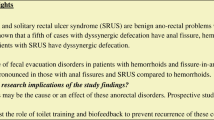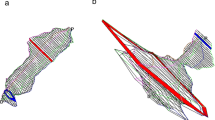Abstract
Tailored lateral shincterotomy (TLS) was designed to preserve more sphincter by tailoring the vertical height of sphincter division to the length of the fissure. The aim of this study was to evaluate prospectively the effect of tailored lateral sphincterotomy on the anal sphincter function in patients with chronic anal fissure. Using a water-perfused 8-channel catheter, a computer-generated anal vector manometric study was performed (preoperatively, 1 and 5 weeks after tailored sphincterotomy) for 30 patients with chronic anal fissure and 20 controls. The mean resting anal pressure (MRAP) in patients with anal fissure was significantly higher (90.93±20.48 cm H2O) than in controls (64.9±11.90 cm H2O). Twenty-one patients (70%) had high MRAP (hypertensive) while 9 patients (30%) had normal MRAP (normotensive). Resting anal pressure at 1 cm from the anal verge (RAP-1 cm) in patients with chronic fissure was significantly higher than global RAP (p=0.00358). There was no significant difference between mean RAP-1 cm of normotensives and hypertensives. Normotensive patients had significantly shorter functional anal canal length (FACL, 2.7±0.26 cm) and shorter high pressure segment (HPS, 0.70±0.26 cm), which is more distally located (D1/D2 ratio, 0.80±0.17) than did hypertensive patients (FACL, 3.30±0.25 cm; HPS, 1.05±0.36 cm; D1/D2=1.18±0.46). The percent MRAP reduction was nearly constant after TLS, regardless of the type of patients (36.85±15.04% in hypertensives, 30.48±16.62% in normotensives). TLS resulted in hypotonia, which was more evident in females (MRAP=57.00±7.75 cm H2O) and normotensive patients (MRAP=48.60±9.08 cm H2O). Two patients (6.66%) had persistent fissure after TLS. Soiling and imperfect control of flatus were reported by two patients (6.66%). Following tailored lateral shincterotomy, the anal physiology was significantly more preserved in hypertensive than in normotensive patients. The success rate of TLS closely approximated that of traditional lateral sphincterotomy with less incidence of continence disorders. A more careful preservation of the sphincter is required in normotensive patients.
Similar content being viewed by others
Author information
Authors and Affiliations
Additional information
Received: 18 July 2000 / Accepted in revised form: 1 October 2000
Rights and permissions
About this article
Cite this article
Hussein, A., Shehata, M., Zaki, Y. et al. Computerized anal vector manometric analysis in patients treated by tailored lateral spincterotomy for anal fissure. Tech Coloproctol 4, 143–149 (2000). https://doi.org/10.1007/s101510070006
Issue Date:
DOI: https://doi.org/10.1007/s101510070006




